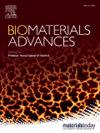姜黄素包覆的明胶海绵具有止血、抗炎和抗疤痕的协同作用。
IF 5.5
2区 医学
Q2 MATERIALS SCIENCE, BIOMATERIALS
Materials Science & Engineering C-Materials for Biological Applications
Pub Date : 2024-12-20
DOI:10.1016/j.bioadv.2024.214155
引用次数: 0
摘要
术后伤口愈合已被广泛研究和充分记录。明胶海绵通常用于外科手术中的血液吸收。如果这些海绵还能释放具有抗疤痕和抗炎作用的药物,它们将显著促进伤口愈合。本研究首次采用电子束沉积法(EBD)研究了姜黄素薄膜在明胶海绵表面的高效止血作用。采用1H NMR、FT-IR和XPS技术对姜黄素的结构进行了分析。我们考察了薄膜对海绵吸收能力的影响以及海绵对药物释放动力学的影响。结果表明,姜黄素膜的存在不影响海绵的止血能力。此外,与平坦的基底相比,这种高度多孔的基底上的姜黄素膜促进了姜黄素的更好释放。进一步的实验,包括细胞毒性试验、活/死双染色、免疫印迹和小鼠疤痕模型,表明明胶海绵与姜黄素膜具有协同作用,具有抗疤痕、抗炎和止血的特性。本文章由计算机程序翻译,如有差异,请以英文原文为准。

The gelatin sponge loaded with curcumin coating exhibits a synergistic effect of hemostasis, anti-inflammatory, and anti-scarring
Postoperative wound healing has been extensively studied and well-documented. Gelatin sponges are commonly used in surgeries for blood absorption. If these sponges can also release drugs with anti-scarring and anti-inflammatory effects, they would significantly enhance wound healing. In this study, we investigated for the first time the application of curcumin films on the surface of gelatin sponges with high hemostatic efficiency using the Electron Beam Deposition (EBD) method. The structure of curcumin was analyzed using 1H NMR, FT-IR and XPS techniques. We examined the influence of the film on the sponge's absorption capacity and the impact of the sponge on drug release kinetics. Results showed that the presence of the curcumin film did not compromise the sponge's hemostatic ability. Additionally, compared to a flat substrate, the curcumin film on this highly porous substrate facilitated better curcumin release. Further experiments, including cytotoxicity tests, live/dead double staining, western blotting, and a scar model in mice, demonstrated that gelatin sponges with curcumin films exhibit a synergistic effect, combining anti-scarring, anti-inflammatory, and hemostatic properties.
求助全文
通过发布文献求助,成功后即可免费获取论文全文。
去求助
来源期刊
CiteScore
17.80
自引率
0.00%
发文量
501
审稿时长
27 days
期刊介绍:
Biomaterials Advances, previously known as Materials Science and Engineering: C-Materials for Biological Applications (P-ISSN: 0928-4931, E-ISSN: 1873-0191). Includes topics at the interface of the biomedical sciences and materials engineering. These topics include:
• Bioinspired and biomimetic materials for medical applications
• Materials of biological origin for medical applications
• Materials for "active" medical applications
• Self-assembling and self-healing materials for medical applications
• "Smart" (i.e., stimulus-response) materials for medical applications
• Ceramic, metallic, polymeric, and composite materials for medical applications
• Materials for in vivo sensing
• Materials for in vivo imaging
• Materials for delivery of pharmacologic agents and vaccines
• Novel approaches for characterizing and modeling materials for medical applications
Manuscripts on biological topics without a materials science component, or manuscripts on materials science without biological applications, will not be considered for publication in Materials Science and Engineering C. New submissions are first assessed for language, scope and originality (plagiarism check) and can be desk rejected before review if they need English language improvements, are out of scope or present excessive duplication with published sources.
Biomaterials Advances sits within Elsevier''s biomaterials science portfolio alongside Biomaterials, Materials Today Bio and Biomaterials and Biosystems. As part of the broader Materials Today family, Biomaterials Advances offers authors rigorous peer review, rapid decisions, and high visibility. We look forward to receiving your submissions!

 求助内容:
求助内容: 应助结果提醒方式:
应助结果提醒方式:


